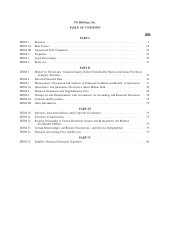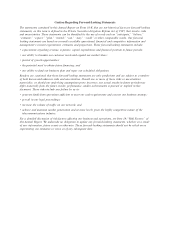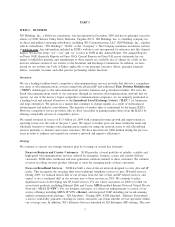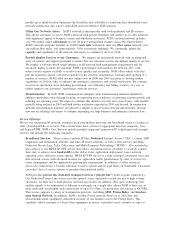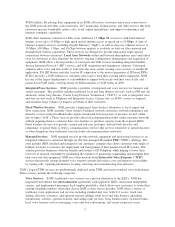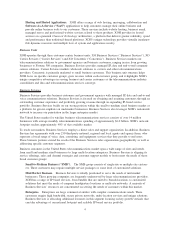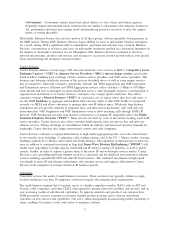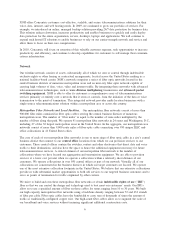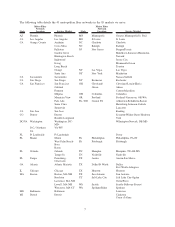XO Communications 2009 Annual Report Download - page 13
Download and view the complete annual report
Please find page 13 of the 2009 XO Communications annual report below. You can navigate through the pages in the report by either clicking on the pages listed below, or by using the keyword search tool below to find specific information within the annual report.In order to secure renewal of our LMDS licenses, we must generally be in compliance with all relevant FCC
rules and demonstrate that we are providing “substantial service” in our licensed areas. As of December 31,
2009, substantial service showings for 43 of our LMDS licensed markets have been approved by the FCC. The
remaining 48 LMDS substantial service demonstrations have been granted an extension until June 1, 2012 by
the FCC. While management expects that we will be able to secure FCC approval of any substantial service
filings in relation to the 48 licenses for which we received an extension, there is no assurance that we will
receive such FCC approval.
Our wireless services are provisioned through exclusively licensed LMDS fixed wireless spectrum or common
carrier spectrum. The properties of XOH’s LMDS spectrum allow it to deliver voice and data connectivity to
customers at rates of up to 1 Gbps, providing them access to high bandwidth applications. In addition, unlike
the spectrum deployed by many other fixed wireless providers, XOH’s LMDS spectrum allows point-to-multi-
point applications, making its services useful in the deployment of aggregation networks. However, unlike
lower frequency transmissions, the signals transmitted through XOH’s LMDS spectrum generally will not
penetrate trees, walls, glass or other path-obstructing materials. We typically address these Line-Of-Sight
(LOS) challenges by installing intermediate sites to overcome transmission obstacles. This solution is generally
sufficient for services to telecommunications carriers, who sell directly to end-users. However, these LOS
challenges, along with the complexities of installation, billing, and caring for end-user customers limit XOH’s
plan to market wireless services directly to retail end-users.
Competition
The telecommunications industry is an intensely competitive environment with numerous competitors includ-
ing ILECs, CLECs, ISPs, VoIP carriers, cable-based communications providers and fixed wireless carriers. The
attributes that we believe differentiate us from our competition are the integration of our nationwide high-
capacity fiber and wireless networks, advanced IP and converged communications services, and a responsive,
customer-focused orientation. We compete in the markets for wireline and fixed wireless telecommunications
services within the United States. These markets are rapidly changing due to the emergence of new
technologies and service offerings, industry consolidation, and an evolving regulatory environment.
CLECs and other competitive network providers such as XOH have provided telecommunications services for
many years; nevertheless, the market for telecommunications services remains dominated by the ILECs, each
of which owns the majority of the local exchange network in its respective operating region of the United
States and extensive national and often international networks and operations. The ILECs are our primary
competitors for voice, data and internet services provided to business customers. We compete on the basis of a
superior value proposition composed of our ability to provide nationwide service, innovative offerings, a
competitive price and our commitment to customer service. While we believe that we have competitive
advantages over the ILECs, each ILEC has significantly more resources available to expand its penetration
into the business marketplace.
In addition to competing with ILECs, we also compete with many CLECs, some of which are regionally
focused. We believe that our national reach, breadth of services, and competitive pricing makes us competitive
with CLECs. Recent industry consolidation has eliminated a number of these, resulting in larger competitors
that may have greater economies of scale and more extensive service footprints and are likely to result in the
combined companies becoming even more formidable competitors.
In addition, new competitors such as VoIP providers and cable companies have entered the market to compete
with traditional, facilities-based telecommunications services providers. Several companies provide integrated
telecommunications services exclusively by means of IP. Many hosted VoIP providers also aggressively
compete for business customers; to date, most of these providers operate on a local or regional basis. Cable
companies, such as Cox Communications, Comcast and Time Warner have begun aggressively marketing their
voice and broadband data connection services into the business telecommunications market. Several regional
9


